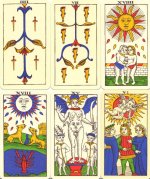trzes
This deck is a real oddity by Rigel Press, published in 1975, a Marseille style deck, redrawn, if it is based on a historical deck at all. The Majors have elements of both the Type I and Type II pattern. Going by the guide to distinguish both (here: https://www.apprendre-tarotdemarseille.com/histoire/les-types-de-tarots/ ), then Lovers, Chariot and World are like Type II, while Devil, Moon and Sun are like Type I. Cards are untitled, so the fool's name doesn’t even provide a majority. The deck has Spanish looking symbols for wands (these irregular clubs). Swords and Wands are small and don't intersect.
On the box it says
That sounds rather dubious. A deck with Marseille Type II elements should be at least past 1700. And a deck found in the British Museum makes it as English as the Rosetta stone. Furthermore, is there any historic Marseille style deck that has these simplified half-Spanish pip cards? I have never seen one.
I suspect that this deck is by no means a historical reproduction, but a modern take that is in general terms based on the Marseille pattern.
The concept of this deck is quite similar to the Richard Gardner Tarot aka Insight Institute Tarot which has plain pip symbols for minors, High Priestess, Empress and Emperor in RWS-Style together with otherwise Marseille style Majors and Courts and those odd pinky pastel colors. It was republished in the 1970s as "R. G. Tarot Cards" calling it "Original English Pack Design", according to different forum as well as WOPC ( http://www.wopc.co.uk/tarot/insight-institute ).
However the "Authentic English Fortune Telling Tarot Cards" have a different design than the cards from the Gardner tarot. I attached a comparison.
Does anyone know whether the "Authentic" is a follow-up for the "Gardner", also by Richard Gardner? And is there any support for the claim that it is based on a particular historic deck?
On the box it says
These Tarot Cards are authentic and based on an original design from the 15th Century to be found in the British Museum.
That sounds rather dubious. A deck with Marseille Type II elements should be at least past 1700. And a deck found in the British Museum makes it as English as the Rosetta stone. Furthermore, is there any historic Marseille style deck that has these simplified half-Spanish pip cards? I have never seen one.
I suspect that this deck is by no means a historical reproduction, but a modern take that is in general terms based on the Marseille pattern.
The concept of this deck is quite similar to the Richard Gardner Tarot aka Insight Institute Tarot which has plain pip symbols for minors, High Priestess, Empress and Emperor in RWS-Style together with otherwise Marseille style Majors and Courts and those odd pinky pastel colors. It was republished in the 1970s as "R. G. Tarot Cards" calling it "Original English Pack Design", according to different forum as well as WOPC ( http://www.wopc.co.uk/tarot/insight-institute ).
However the "Authentic English Fortune Telling Tarot Cards" have a different design than the cards from the Gardner tarot. I attached a comparison.
Does anyone know whether the "Authentic" is a follow-up for the "Gardner", also by Richard Gardner? And is there any support for the claim that it is based on a particular historic deck?



